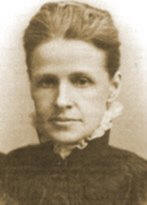
Picture courtesy of the UUA Archives.
In 1880
Mary Augusta Safford was invited to Humboldt's Unity Church. She
remained in the community for five years before she was invited to Sioux
City.
Mary
was born at Quincy, Illinois, December 23, 1851. At the age of eighteen
she entered the State University at Iowa City. She spent several years
there studying and teaching. After leaving school, she joined her
parents in Hamilton, Illinois and began to preach there.
It was
in Hamilton that Mary organized a Unitarian Society in 1878. She
preached in Hamilton a year and a half and then was invited by the Iowa
Unitarian Association to be ordained in the State of Iowa. She received
her ordination while in Humboldt. Mary remained in Humboldt for five
years. She was a woman of great energy, and enthusiasm. She was well
liked in Humboldt and attracted many new members to the Unitarian
Church.
In
1871, Miss Safford founded the Hawthorne Literary Society, a forum for
the sharing of new ideas. The organization presented book reviews,
essays, poetry readings, and plays. There was occasionally a guest
lecturer. She continued the Literary Society in Humboldt, for both
young people and adults. The Literary Clubs were well received. S. H.
Taft was a frequent guest speaker at the meetings.
In
addition to the literary, educational and humane work of her church,
Miss Safford was an ardent woman suffragist. After leaving Humboldt she
when on to Sioux City, and then to Des Moines. In these larger cities
she was received as favorably as she had been in Humboldt.
She
retired to Florida. But she continued her work of organizing Unitarian
Churches. In 1927, after suffering a stroke in Orlando, Florida,
Safford died. Her body was returned by train, traveling northward along
the Mississippi River, to Hamilton, Illinois for burial.
Mary
Augusta Safford will be remembered as a Unitarian minister with
remarkable energy, zeal and dedication. She did much to promote the
growth of Unitarian churches in the Middle West during the late 19th
century. The central figure in a framework of women Unitarian ministers
known alternately as the "Iowa Sisterhood" or the "Iowa Band," she led
her ministerial colleagues in their common work of founding and serving
new Unitarian churches in Iowa, Illinois, Minnesota, and North and South
Dakota.

